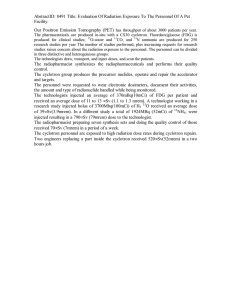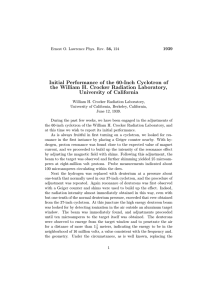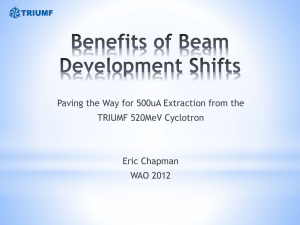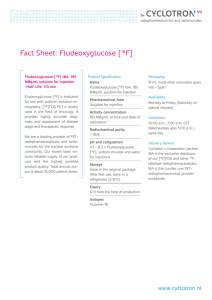LBNL 88-Inch Cyclotron Improvements
advertisement
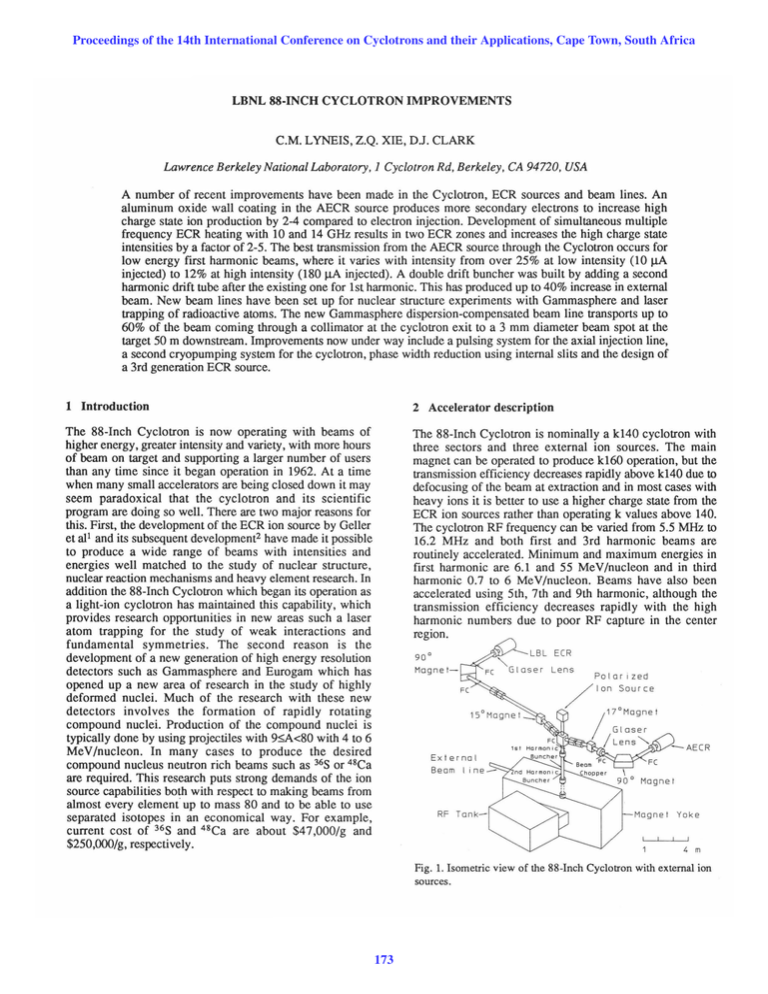
Proceedings of the 14th International Conference on Cyclotrons and their Applications, Cape Town, South Africa LBNL 88-INCH CYCLOTRON IMPROVEMENTS C.M. LYNEIS, Z.Q. XIE, DJ. CLARK Lawrence Berkeley National Laboratory, 1 Cye/otron Rd, Berkeley, CA 94720, USA A number of recent improvements have been made in the Cyclotron, ECR sources and beam lines. An aluminum oxide wall coating in the AECR source produces more secondary electrons to increase high charge state ion production by 2-4 compared to electron injection. Development of simultaneous multiple frequency ECR heating with 10 and 14 GHz results in two ECR zones and increases the high charge state intensities by a factor of 2-5. The best transmission from the AECR source through the Cyclotron occurs for low energy first harmonic beams, where it varies with intensity from over 25% at low intensity (10 JlA injected) to 12% at high intensity (180 JlA injected). A double drift buncher was built by adding a second harmonic drift tube after the existing one for 1st harmonic. This has produced up to 40% increase in external beam. New beam lines have been set up for nuclear structure experiments with Gammasphere and laser trapping of radioactive atoms. The new Gammasphere dispersion-compensated beam line transports up to 60% of the beam coming through a collimator at the cyclotron exit to a 3 mm diameter beam spot at the target 50 m downstream. Improvements now under way include a pulsing system for the axial injection line, a second cryopumping system for the cyclotron, phase width reduction using internal slits and the design of a 3rd generation ECR source. 1 Introduction 2 Accelerator description The 88-Inch Cyclotron is now operating with beams of higher energy, greater intensity and variety, with more hours of beam on target and supporting a larger number of users than any time since it began operation in 1962. At a time when many small accelerators are being closed down it may seem paradoxical that the cyclotron and its scientific program are doing so well. There are two major reasons for this. First, the development of the ECR ion source by Geller et all and its subsequent development2 have made it possible to produce a wide range of beams with intensities and energies well matched to the study of nuclear structure, nuclear reaction mechanisms and heavy element research. In addition the 88-Inch Cyclotron which began its operation as a light-ion cyclotron has maintained this capability, which provides research opportunities in new areas such a laser atom trapping for the study of weak interactions and fundamental symmetries. The second reason is the development of a new generation of high energy resolution detectors such as Gammasphere and Eurogam which has opened up a new area of research in the study of highly deformed nuclei. Much of the research with these new detectors involves the formation of rapidly rotating compound nuclei. Production of the compound nuclei is typically done by using projectiles with 9~<80 with 4 to 6 MeV/nucleon. In many cases to produce the desired compound nucleus neutron rich beams such as 36S or 48Ca are required. This research puts strong demands of the ion source capabilities both with respect to making beams from almost every element up to mass 80 and to be able to use separated isotopes in an economical way. For example, current cost of 36S and 48Ca are about $47 ,OOO/g and $250,OOO/g, respectively. The 88-Inch Cyclotron is nominally a k140 cyclotron with three sectors and three external ion sources. The main magnet can be operated to produce kl60 operation, but the transmission efficiency decreases rapidly above k140 due to defocusing of the beam at extraction and in most cases with heavy ions it is better to use a higher charge state from the ECR ion sources rather than operating k values above 140. The cyclotron RF frequency can be varied from 5.5 MHz to 16.2 MHz and both first and 3rd harmonic beams are routinely accelerated. Minimum and maximum energies in first harmonic are 6.1 and 5 5 MeV/nucleon and in third harmonic 0.7 to 6 MeV/nucleon. Beams have also been accelerated using 5th, 7th and 9th harmonic, although the transmission efficiency decreases rapidly with the high harmonic numbers due to poor RF capture in the center region. 90° Magne t- Lens Polarized External Magnet Yoke 4 m Fig. 1. Isometric view of the 88-Inch Cyclotron with external ion sources. 173 Proceedings of the 14th International Conference on Cyclotrons and their Applications, Cape Town, South Africa 3. System performance Currently all beams being used by the research programs are produced by the two high charge state ECR ion sources located on the vault roof of the cyclotron as shown in Fig. 1. The LBL ECR ion source3 began operation with the cyclotron in 1985 and a second higher performance source the Advanced ECR4 was brought into operation in 1990. The horizontal beam lines for each source contain a double focusing 90 degree analyzing magnet with slits at the image and object for charge state selection. Ion beams from either source can be selected by reversing the 75 degree bending magnet at the top of the axial injection line and injected into the cyclotron. There are several advantages to having two ECR ion sources for the cyclotron. From the point of view of operations it allows "beam development" in terms of developing a specific ion beam from the ECR source without taking accelerator time. For difficult beams requiring ovens, isotopic feeds or maximum ion source performance the ion source can be brought on early and a rapid changeover to the next beam can be made. From the point of view of ion source development it is essential to have a second source especially when the cyclotron is operating 7 days a week with only one 8 hour shift for maintenance each week. The axial beam line uses three solenoid lenses to transport the beam onto the gridded electrostatic inflector located on the axis of the cyclotron. Beam bunching is provided by a first harmonic buncher located 2.5 m above the cyclotron mid plane and a new second harmonic buncher located 0.4 m below the first harmonic buncher. The bunchers are both two gap devices with tungsten wire grids to provide the equipotential surfaces. The phase and amplitude of each buncher can be independently adjusted to maximize transmission. Typical bunching factors are 3 for the first harmonic buncher and 4.5 for both bunchers. An axial line chopper was recently installed to provide chopping of the beam injected into the cyclotron. The present rise time is about 7 Ils and modification of the drive circuits are underway to provide 1 Ils rise time. This chopper is used for experiments with collection wheels and for experiments where the researchers need to control the integrated flux on target. The evolution of the heavy-ion performance of the 88-Inch Cyclotron is illustrated in Fig. 2. These curves are drawn for beams of at least 1 particle nA extracted current, which is a typical intensity required for nuclear structure experiments, and the dashed line at 5 Me V/nucleon indicates the approximate cutoff in energies useful for nuclear science experiments. Higher intensity beams can be produced at energies less than those indicated by the curves. Prior to the operation with the first ECR ion source the heavy-ion operation was limited to elements with mass 40 or below. The LBL ECR began regular operation with the Cyclotron in January 1985 and it reached its full operating potential a few years later. With this source it was possible to accelerate masses up to xenon at useful intensities and energies. In 1990 the AECR began operation and with improvements in its performance described below it is now possible to reach masses up to 160. A conceptual design for a 3rd Generation ECR sources which would extend the energy mass characteristics of the cyclotron significantly is underway and the cyclotron's projected performance is indicated with a dashed line in Fig. 2. Along with developing higher ion source performance with respect to producing higher charge states and higher intensities, the development of a wide range of beams has been an important aspect of providing new research opportunities at the cyclotron. Both the LBL ECR and the AECR have radial access ports provided by slots in the sextupole structure which allow ovens to be installed. The oven technology was first developed on the LBL ECR.6 Ovens are now in use with many ECR ion sources although they are typically mounted on axis and with maximum temperatures of 1500 °C. The high temperature oven developed for the ECR ion sources at Berkeley can operate up to 2100 °C which can evaporate more elements. To date, the 88-Inch Cyclotron has produced beams of 41 elements, from hydrogen through zinc (the first 30 elements) as well as Ge, Kr, Ag, Sn, Xe, La, Sm, Tb, Au, Bi and U. Efficient use of separated isotopic feed material has been developed with the ECR sources also. For example in FY94 more than 300 hours of research utilized 48Ca beams. For these experiments, which required about 2 particle nA on target, typical usage rates of 40% enriched 48Ca were 20 to 30 Ilg/hr. Several factors go into the overall efficiency including the source efficiency, the injection and extraction efficiency and beam transmission to the experimental target. In a typical experiment about 150 particle nA of Ca lO + is produced by the ECR source (to minimize consumption), 15 particle nA is extracted from the cyclotron, and 5 particle nA is delivered to the Cave 4c where Gammasphere is located. This represents an order of magnitude improvement in transmission efficiency compared above that achieved in the first few years of operation the LBL ECR. The improved overall transmission is a result of improvements in the transport through the injection line, higher bunching efficiency with the second harmonic buncher, better cyclotron settings and improvements in the beam transport system to the cave. 35 Performance of the SS-Inch Cyclotron for Heavy Ions at 1 particle nA 0~----~------~------+-----~------4 50 ,100M ' 150 Particle ass In amu 200 250 Fig. 2. This shows the energy mass curves for the cyclotron at an intensity of 1 particle nA. 174 Proceedings of the 14th International Conference on Cyclotrons and their Applications, Cape Town, South Africa 30 ~------------------------------,r0 ---... . . . . . .-r 25 <l!- e: .2 on 20 .!Il E on 15 ~ I- 10 e: 5 0 with neutral atoms. As part of the project a second CT-1400 is being installed to provide additional cooling capacity and some redundancy on the cryopumping system. A second project is underway to control the phase width of the cyclotron and develop techniques to reduce it to .1 ns for third harmonic beams. A fast Faraday cup has been Installed in the Cave 4C beam line along with a fast counting system to provide accurate measurement of the phase width. The effectiveness of reducing the phase width through reduction of the phase acceptance of the cyclotron by detuning the magnetic field or by using internal slits to select a narrow phase width at small radius in the cyclotron are being tested. The effect of the RF amplitude stability on beam phase width is also being investigated. Preliminary results indicate that it may be possible to achieve 1 ns beam pulse without requiring single turn extraction. ....•......•.................. .•.... ... 5 ~ o c ~ 15 <.J -c 10 -ti ~ w 5 4-.-~~--~----~--.-r---~----1~00 3 60 90 Ion source current in jJA Fig. 3. Transmission of 0 6 + from the AECR through the Cyclotron as a function of injection current. The transmission of beams from the ion source through the cyclotron depends several factors. For example the transmission of first harmonic is typically better than third harmonic. It decreases slightly as the main field is increased and also depends on vacuum. The losses due to vacuum are also strongly charge state dependent, with the greatest losses occurring for very high charge state ions. The losses are especially noticeable for very high charge state ions such as 154Sm35+ where the losses associated with charge exchange reduced the transmission by a factor of 4 for a vacuum of about 7xlO-7 Torr. Most of the beam loss for the very high charge state ions appear to be electron capture at small radius in the cyclotron. At low energy the electron capture cross section scales approximately as q3.7 Figure 3 indicates the dependence of the transmission efficiency on the injection current for 0 6 + ion beams at 10 MeV/nucleon (first harmonic beam). At low intensity the transmission is 28% (10 ellA injected and 2.8 ellA extracted) and this decreases to about 12% at high intensity (180 ellA injected and 22 ellA extracted). The transmission efficiency decreases as the injection current is increased and the relative decrease becomes smaller at higher injection currents. Therefore an increase of total extracted current still can be achieved with higher injection currents . The decrease in transmission efficiency is most likely due to defocusing effects of the beam space charge. The typical vacuum in the injection beam line is 1 x 10-8 Torr and it appears that the beams are not being space charge neutralized. 8 There are two approaches to reduce this effect. First, by increasing the injection voltage. The 88-Inch Cyclotron is normally operated at maximum Dee voltage (50 kV) and the source voltage is set at 1/5th that value (10 kV) to provide beam centering. However, tests indicate that beam centering can still be achieved at 15 kV injection voltage. Second, the space charge effects can be reduced by increasing the number of focusing elements in the horizontal and axial injection lines. We have done tests to determine the maximum extracted intensity of the present system using the AECR and the cyclotron at about 6 MeV/nucleon for Ar9+ (2.2 particle IlA) and Kr19+ (0.30 particle 1lA). A project to improve the vacuum in the cyclotron is nearing completion. This will add a new cryopanel to the cyclotron tank to reduce the losses due to charge exchange 4 ECR Ion Source Development As illustrated in Fig. 2, ECR source development has played a key role in expanding the performance of the 88Inch Cyclotron. Recent modifications of the AECR source have increased its performance particularly for heavy high charge state ions. The first modification was to replace the copper components which comprise the plasma chamber (the extraction plate, injection section and sext~pole housing with new components made from alumlOum. Enhanced production of high charge state ions has been demonstrated on various ECR ion sources. 9-11 An Al 2 0 3 layer forms on the aluminum provides a high electron emission surface which supplies cold electrons for the plasma which results in a reduction of the plasma potential and enhancement on the production of high charge states. 10 The second modification was to install a second waveguide into the plasma chamber so that the plasma could be heated by 10 and 14 GHz microwave power simultaneously. As described in more detail elsewhere,12 the motivation for this was to provide two concentric shells where the ECR resonance condition is satisfied and thereby improve the RF heating of the electrons. The magnetic field shape of the AECR source can be adjusted so that closed and well separated ECR resonance surfaces at both 10 and 14 GHz coexist. With this two-frequency heating the AECR plasma was more quiescent than single-frequency heating. The short-term and the long-term plasma stability were both improved and more total microwave power could be launched into the plasma. The AECR could be operated with reduced gas input which indirectly indicates operating at lower neutral pressures since the mechanical pumping speed is the same. The optimum gas and oven vapor input levels are reduced by roughly 30% to 50% while the total extracted currents remain essentially the same as with singlefrequency heating. The performance of the AECR source with twofrequency heating is significantly better than the results obtained with single-frequency heating. The greatest improvement is for the highly charged ions. For example, increases up to an order of magnitude for the very high charge state of bismuth and uranium ions were achieved. With the improved performance, at least 5 enA of fully 175 Proceedings of the 14th International Conference on Cyclotrons and their Applications, Cape Town, South Africa stripped Ar ions were produced. Figure 4 shows the best charge state distributions of 238U obtained with singlefrequency and two-frequency heating from the AECR source. With about 15% more microwave power compared to the optimum single-frequency heating, two-frequency heating shifted the peak charge state from 33+ to 36+ and increased the intensity by a factor of 2 to 4 higher for charge states from 35+ to 39+. lO.OO~ <g - sextupole magnet will be installed to increase the radial magnetic field at the wall from 0.64 to 1.0 Tesla.13 A 3rd Generation ECR source is being designed to produce higher charge states and intensities so the 88-lnch Cyclotron can deliver useable heavy ion beams such as bismuth and uranium at energies above 5 MeV/nucleon. ECR source development, especially in the last few years, indicates that further enhancement of the production of high charge state ions by ECR sources is possible with higher field strengths and higher magnetic mirror ratios,14 chamber surface with high secondary emission materials and heating the plasma with multiple frequency microwave power. 12 The solenoid and sextupole magnets of this new source will be made from superconductor to produce the high magnetic field strengths. The design fields are more than 3 T in the axial direction and up to 2.5 T radial field at the plasma wall. This would provide mirror ratios of 15 at injection and 10 at extraction. _ _ _ _ _ _ _ _ _ _ _ _ _ _ _ _---. 1.0 2 O.1~""""---'!'!30----"'''----40----"''''''' Acknowledgments Q Fig. 4 Charge state distributions for 238U produced with the AECR source are shown for single-frequency (14 GHz, curve 1) and two-frequency (14 + 10 GHz, curve 2) heating. This work was supported by the Director, Office of Energy Research, Office of High Energy and Nuclear Physics, Nuclear Physics Division of the U.S. Department of Energy under Contract DE AC03-76SF00098. The improved performance of the AECR source with two-frequency heating makes it possible for the 88-lnch Cyclotron to accelerate the very heavy ions such as bismuth and uranium to an energy greater than 5 MeV/n. Table 1 shows the highly charged ions obtained with the twofrequency heating and accelerated through the 88-lnch Cyclotron. References 1. 2. 3. Table 1: Beams Produced by Two-frequency Heating and Accelerated by the 88-lnch Cyclotron Ion Extracted Cyclotron Current (enA) 86Kr30+ 0.22 209Bi 45 + 0.5 209Bi 47 + 0.33 209Bi49 + 0.021 209Bi50+ 0.015 209Bi51 + 0.004 238 U52+ 0.017 238U53+ 0.008 4. Energy (MeV) 1408.1 1309.4 1427.9 1551.7 1615.4 1680.3 1562.0 1662.9 5. (MeV/n) 16.37 6.27 6.83 7.42 7.73 8.04 6.56 6.99 6. 7. 8. 9. 10. An upgrade of the AECR is underway to modify its magnetic structure to improve the plasma confinement to further enhance the source performance. The existing solenoid magnets will be replaced by new ones with larger conductors and higher maximum current density. With these modifications and at the same total dc magnet power of 75 kW as the existing configuration, the peak field strengths at the injection and the extraction regions will increase about 70%. The central field strength will remain the same which produces mirror ratios of 4.1 at injection and 3.0 at extraction. The wall thickness of the new aluminum plasma chamber wall be reduced and a stronger permanent 11. 12. 13. 14. 176 Geller, R, Appl. Phys. Lett. 16, No 10,401 (1970). R Geller, IEEE Trans. NS.:26.. No.2, 2120 (1979). C.M. Lyneis, Proceedings of the 6th International Workshop on ECR Ion Source, Berkeley, CA, USA, 1986, p. 51. Z.Q. Xie, C.M.Lyneis, RS. Lam, and S.A. Lundgren, Rev. Sci. Instrum. 62,775 (1991). C.M. Lyneis and Z.Q. Xie, Proceedings of the 12th International Workshop on ECR Ion Sources, RlKEN, JAPAN, April 1995, p. 119. D.1. Clark and C.M. Lyneis, 1. Phys. (Paris) Colloq. 50, Cl-759 (1989). A.S. Schlachter, Proceedings of the 10th International Conference on Cyclotrons and Their Applications, E. Lansing, USA, April 1984, p. 563. Z.Q. Xie and T.A. Antaya, Rev. Sci. Instrum., 61,793 (1990). T. Nakagawa et al, Jpn. 1. Appl. Phys. 32, 1335 (1993). Z.Q. Xie and C.M. Lyneis, Rev. Sci. Instrum. 65, (1994) 2947. D. Hitz et aI, Proceedings of the 12th International Workshop on ECR Ion Sources, RlKEN, JAPAN, April 1995, p. 126. Z.Q. Xie and C.M .Lyneis, Rev. Sci. Instrum. 66,4218 (1995). Z.Q. Xie and C.M. Lyneis, Proceedings of the 12th International Workshop on ECR Ion Sources, RlKEN, JAPAN, April 1995, p. 24. T.A. Antaya and S. Gammino, Rev. Sci. Instrum. 65, 1723 (1994).
